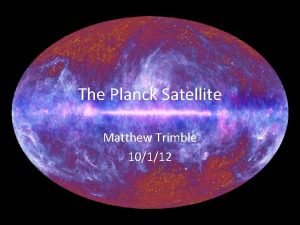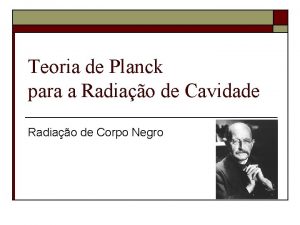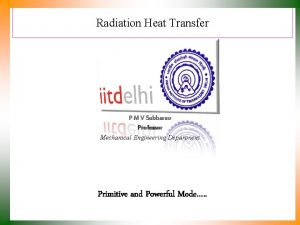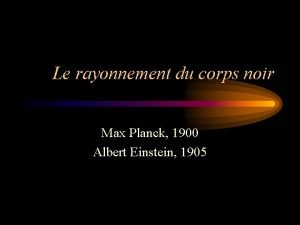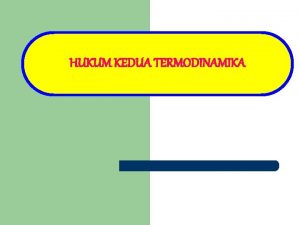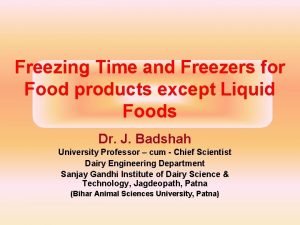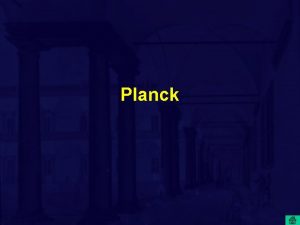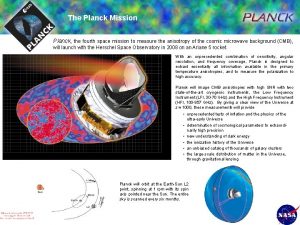US Planck Data Analysis Review Source Extraction Tim





- Slides: 5

US Planck Data Analysis Review Source Extraction Tim Pearson US Planck Data Analysis Review • 9 -10 May 2006

ERCSC Source Extraction (1/4) Locate sources in single-band maps (detection) – Filter maps and search for peaks Ø Matched filters (with assumptions about noise statistics) Ø Other approximate filters (e. g. , mexican hat) Ø Bayesian methods Estimate source parameters (extraction) – Position, flux density – Polarization (Q, U) for bright sources – Angular size (resolved sources): best effort Band merge (best effort) – Cross-correlation of single-band catalogs – Parameter estimation using simultaneous fits to several bands Ø Spectral index Ø SZ cluster detection (multifilters? Herranz et al. 2005) Tim Pearson 2 US Planck Data Analysis Review • 9 -10 May 2006

ERCSC Source Extraction (2/4) Make use of published algorithms – Development of new algorithms may occur but is not necessary to meet goals Use code developed elsewhere when possible Write new code as necessary Compare algorithms using simulated sky maps and WMAP data – Compare extracted source parameters with input – As a function of source flux density – In regions with different foreground contamination Estimate reliability and completeness – Reliability: fraction of sources found that are real – Completeness: fraction of real sources that are found Estimate parameter accuracy – Positional accuracy – Photometric accuracy Choose one algorithm that meets requirements – Balance criteria of reliability, completeness, accuracy, run time – Implement full pipeline and test with simulated data Continue investigation of alternative algorithms Tim Pearson 3 US Planck Data Analysis Review • 9 -10 May 2006

ERCSC Source Extraction (3/4) Some Proposed Algorithms Matched filter Ø Optimum linear filter when beam and noise power spectrum are known Ø e. g. , Tegmark & de Oliveira-Costa 1998; used successfully for WMAP Mexican hat wavelet Ø Approximation to matched filter, may be easier to use Ø Cayón et al. 2000; Vielva et al. 2001, 2003 Neyman-Pearson detector and biparametric scale adaptive filter Ø Controversial, needs careful evaluation Ø López-Caniego et al. 2005 Adaptive top-hat filter Ø Chiang et al. 2002 Bayesian approaches (MCMC) Ø Non-linear, can do better than matched filter Ø Hobson & Mc. Clachlan 2003 Ø Savage & Oliver 2005 Ø “Powell-Snakes” fast Bayesian method (Rocha et al. in prep) Other methods – MOPEX Ø Makovoz & Marleau 2005 – Sextractor Ø Bertin & Arnouts 1996 (blended sources) – etc. Tim Pearson 4 US Planck Data Analysis Review • 9 -10 May 2006

ERCSC Source Extraction (4/4) Example Matched filter based on the symmetrized beam from 30 GHz and from the (smoothed) power spectrum of the total map. 60 -deg section of full simulated sky, before and after filtering (no Galactic foregrounds) Tim Pearson 5 US Planck Data Analysis Review • 9 -10 May 2006
